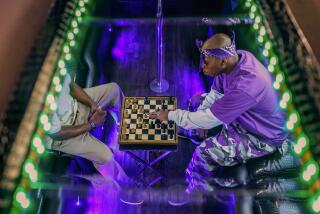GAMES : Terrace: The Next Generation
- Share via
You have to have a bit of an eye for it, but if you’re a fan of “Star Trek: The Next Generation,” you may have noticed that when Enterprise crew members are loafing in the “10-Forward” lounge, some of them are doing something other than swilling iridescent futuristic cocktails.
Yes, there in the background, somewhere behind a Whoopi Goldberg Frisbee-like chapeau, they’re playing . . . what? Chess? Some 23rd-Century brain-bender?
Nope. The pleasantly contoured board game they’re sweating over is a late 20th-Century invention out of Lake Oswego, Ore.
It’s called Terrace and, like many of the most absorbing and baffling games (it has been favorably compared to chess) it is simple to learn but almost impossible to get a firm handle on.
The setup and the rules are elegant and easy:
The board consists of 64 squares in an 8-by-8 grid, the same as in chess (apart from the fact that the board is terraced). But the Terrace board, unlike chess, not only allows movement on one level (forward, backward and sideways), but also vertical movement (to higher or lower levels on the terrace).
The object of the game is to capture your opponent’s “T” piece (the smallest piece, marked with a “T”) or to advance your own “T” to the lowest square across the board.
There are only four ways to move a piece: 1) on the same level, a piece can move to any vacant square that it can reach without jumping over an opponent’s piece; 2) the piece can move straight up or diagonally up, one square at a time, to a vacant square on the next higher level; 3) the piece can move straight down, one square at a time, to a vacant square on the next lower level; 4) the piece can move diagonally down to capture an opponent’s piece that is the same size or larger.
It is even legal--and sometimes desirable, if strategy warrants it--to capture one of your own pieces and remove it from the board in order to, for instance, free a piece that would otherwise be trapped. This “cannibalism” rule, plus the fact that players are simultaneously attacking their opponent’s “T” and trying to defend their own while moving it across the board, opens the door to a broad combination of strategies.
Also, said the game’s co-creator, Buzz Siler, it will probably take decades for computers to “learn” enough strategies and gambits to dominate a game of Terrace, the way they do now in chess. Just about everyone is playing from scratch.
There are three basic board setups, depending on the number of players and the time you want to spend playing: a short game for two that takes about half an hour, a long game for two that can last a couple of hours, and a four-player game that takes about a half hour.
Refining the game took a while. It was designed in 1950 by a Dutch-born mechanical engineer, Anton Dresden. However, Dresden’s rules proved unworkable and the game was relegated to the basement for years. In 1988, Dresden showed Siler the game, Siler bought the design for $100 and hammered out a set of simplified rules. The game was introduced to the market in 1991.
At a suggested retail price of around $30, the game is marketed domestically by Siler/Siler Ventures of Lake Oswego, Ore.


